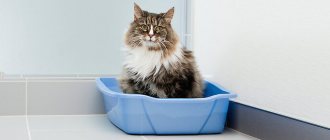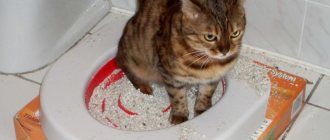The peculiarity of the life of cats suggests that they avoid water procedures because they are afraid of water. In part, this statement is not groundless, but can cats swim? Contrary to the established belief that cats cannot do this, it is worth noting: they swim excellently, and if in case of danger they need to overcome a water barrier, they will do it without difficulty. Moreover, there is a breed of fishing cats, whose life in the wild is unthinkable without hunting in water bodies.
Bathing is stressful
In cats, like most species of mammals, the ability to swim was developed during evolution, even before the process of domestication. In nature, it is survival of the fittest, so from the age of a kitten, animals can float on the water without any problems. In the event of an attack by predators or disasters (floods, fires), saving their own lives, they rush into the water and are able to stay there for a long time. Some individuals are driven into the water by hunger. This happens when there is not enough food on land.
If necessary, the cat can easily overcome water obstacles
Cats swim “like a dog”: scooping up water under themselves with their front paws. It turns out that this is simply wonderful for the cat family, but if you throw your pet into the water to test swimming skills, you can instill in the animal a fear of water procedures for a long time. It is necessary to accustom it gradually and better from an early age, then when bathing the pet will not violently resist.
Much depends on the breed and character of the cat. While some representatives are afraid of even the sounds of flowing water, others bathe with pleasure. Unfortunately they are a minority.
Note! It is more difficult to train an adult cat to bathe than a kitten.
Features of bathing small sphinxes
It’s clear how to bathe an ordinary kitten. However, when it comes to other breeds, a person may become confused. You need to wash hairless Sphynx kittens according to the method presented above. But after the procedure, you need to cover his body with baby cream.
You need to start accustoming cats to water procedures from childhood. While the kitten is small, you can try and instill in him a positive attitude towards water. The most important thing is not to scare him during the first bath and not to cause him pain.
Source
Why cats can't stand water procedures
How to wash a rat at home, accustom it to water
It would seem that for pets, taking water procedures is a common occurrence; for most cats, bathing is still stressful. This is due to genetics, self-defense, again rooted in the distant past.
Maine Coon loves to swim
The instinct of self-preservation forces the cat not to put its own life in danger and not to go into the water unnecessarily, protecting it from a number of dangers:
- Hypothermia. Getting the fur wet can lead to hypothermia. The fact is that in cats there is an air gap between the skin and the pile. It plays the role of a thermostat and prevents the body from becoming overcooled. When the fur gets wet, the layer does not cope with the task, and the animal may simply freeze.
- Overheating. In hot conditions, this same layer saves you from overheating and maintains normal body temperature.
- Smell. Wet wool has a strong odor that attracts predators and repels prey. Cats go hunting, silently sneaking up on prey and attacking from ambush, and the smell of wet fur gives away its location. The opposite situation, when the cat becomes a victim of predators, forces it to avoid getting wet even in the rain.
- Infections. More dirt and microbes that cause various diseases stick to wet wool. When licked, they inevitably enter the body and lead to weakened immunity.
How to wash a kitten for the first time?
the kitten by the withers
placed in water, and it does not matter whether he stands or sits. Continuing to hold the baby, moisten the fur with water from the shower head in the direction from neck to tail and apply shampoo evenly. The shampoo should not get into the eyes, ears or mouth of the animal.
Interesting materials:
Where is the detail in the personal account of tele2? Where is the voice recorder on Honor? Where is DPR located? Where is the front of the building? Where is the state of Germany located? Where is Grigory Melekhov? Where is the edge on the coin? Where is the id in tik tok? Where is the Taxpayer Identification Number located? Where is the source of the Tura River?
What kind of cats love water?
Can dogs and cats laugh?
There are cat breeds that do not have such a negative attitude towards water.
Maine Coon
Cats of this breed, although large, are not at all aggressive, as it seems at first glance. On the contrary, immigrants from the USA have a rather peaceful character and friendliness, and quickly become attached to their owners.
It is worth noting their laziness: animals love to sleep and soak up the sun. However, when it comes to swimming, then a real little devil wakes up in them: they frolic, play, showing the character of a real hunter. The owner runs the risk of getting wet from head to toe, as their activity increases during water procedures.
Bengal cats
But Bengal cats are distinguished by their waywardness. Although they adore affection, they do not tolerate it if it is imposed.
Bengal cats decide when to bathe.
The beauties, with soft fur and a peculiar leopard pattern, are very smart and curious, but if you force them into water, they will certainly show their temper. Despite the fact that they can swim perfectly, cats decide for themselves when to do it.
American Bobtail
Another cat breed from the USA, the American Bobtail, which has more features in common with a dog than with individuals of its own kind, is also not afraid of water. To say that these cats can swim is an understatement. They are not only wonderful swimmers, but they are easy to train and require walking, so why not dogs?
Soukok
Purebred representatives of the African shorthair breed - Soukok - resemble a wild animal in their appearance. They have elongated hind limbs and original coloring. Cats are very energetic and love affection and actively show it themselves, rubbing against their owners’ legs. They are playful and love to frolic on land. If there is a pool at the cottage, they swim with pleasure. In a city apartment, while bathing, they flirt with the stream of water flowing from the tap.
Manx
There are legends about the tailless English Manx that he lost his tail when he jumped on Noah's Ark during the Great Flood. The door slammed at the last moment and cut off his luxurious decoration. This did not deprive them of their natural skills; cats swim perfectly.
Manx are very curious
The water seems to hypnotize them. They can spend hours watching the murmuring of the toilet flush, even flirting with it. They are trying to use it as a source of drinking water, but they do not like to swim forcibly. They do this only if they wish.
“Tactics” for training a cat to use the bathroom
Before teaching a cat not to be afraid of water, you need to overcome all the accompanying discomfort. Carry the animal into the bathroom in your arms; if the cat does not strain, try turning on the water for a short time. Calm your cat down, let him know that he is protected, but be prepared, the sound of running water can throw the cat into panic.
Try putting the animal in a dry bath; most likely, the pet will immediately run away, but this is only the first stage. Agree with your pet, do not try to wet the fur or force the cat not to be afraid, forcing events will only add to the hassle. Gradually, patiently, agreeing to the animal’s conditions and that’s the only way!
Important! Bathroom lighting is a separate issue. It has been established that animals experience fear if there is not enough light in the room. Change the light bulbs to brighter ones or install an additional light above the bathroom while you study.
Naturally, it is easier to accustom a kitten to water; the little one who unconditionally trusts you will accept or at least tolerate water procedures after 3-4 “training swims”. It is difficult, sometimes impossible, to train an adult cat. If your pet doesn't go outside, it's easier to give him a quick bath than to torment him for months of training.
How to accustom a cat to water
How to accustom a cat to a new home - arrangement and adaptation options for your pet
No matter how negatively cats feel about water, they still need to wash themselves. This is a hygienic procedure that allows you to cleanse the animal of parasites after treatment. Here it is important not to make mistakes and remember a few important rules.
If this is already an adult pet, but is experiencing the need for bathing for the first time, it is better to give it a sedative intended specifically for cats before the process. The dosage must be determined by a veterinarian, since, as already mentioned, adult animals have difficulty getting used to this kind of activity.
Water procedures are necessary for pets
While bathing, do not shout at the animal, do not scold it, and be extremely calm yourself. It is better to wash your pet with an assistant whom he knows and trusts. Do not delay the washing process. The water temperature should be comfortable.
Frequent forced bathing is not healthy for cats. Wash them if necessary, if they are very dirty or have fleas. The standard regime is no more than once a year. They are already manic about their own appearance: they constantly lick their fur after every meal and visit to the toilet. Teaching an adult cat to love a bath is difficult.
Note! It is better to teach cats to bathe from childhood.
How to teach an adult animal to take a bath?
Sometimes an adult animal has to be taught to wash, for example, if a person takes in a stray cat. This is a difficult process, since the new ward has already formed a character, and water procedures will be new to him. In this case, you need to try to switch your pet’s attention from the water to something interesting. You need to gradually teach your animal to bathe without stress for him and the owner:
- If the cat does not want to be in the bathroom, he should be taught to go there willingly with the help of treats and toys. The same is done when an animal does not like the sound of water flowing from the tap.
- You also need to train your pet to be calm in the bathing container using toys and games. To begin with, it is better not to pour water into it or add it to a level of 1–2 cm.
- To keep the cat stable and comfortable, place a rubber mat or towel on the bottom of the bathtub or basin.
How to make addiction easier
You need to wash in a shallow basin standing on the floor. Little kittens experience an instinctive innate horror at the sight of high sides of the bathtub and pouring water. They associate them on a subconscious level with flooding, which means they are a command to escape. It’s good if the cat managed to get acquainted with the basin, sniff it, and play in it before bathing.
Bath a kitten from the age of 4 months
Before the process itself, put the kitten in a basin, let it get used to it and run around side by side. Pour non-chlorinated water into it, no more than 5-7 cm. The most comfortable temperature is 38-40 degrees. Place the kitten in the basin. Quickly wet his head, being careful not to get water into his ears and nose.
You need to be patient, do not scold or shout at the baby while bathing; it is better to calm him down with kind words if he meows loudly, showing fear. Do not delay the procedure.
After bathing, the baby should be wrapped in a warm towel, thoroughly blotted, and encouraged: milk, a favorite treat, a toy. If you are shaking, it means you are freezing, you need to change the towel to a dry and warm one, hold it in your arms, and calm it down. Use only special, hypoallergenic shampoos.
Note! Kittens aged 1-3 months should not be bathed unless absolutely necessary. The optimal age for the first wash is 4 months.
If the baby gets dirty in the cat litter box, it is better to wipe it with wet wipes or wash only the paws, but do not bathe the baby completely.
Fear of water or swimming?
Fluffy animals simply do not tolerate water, and they have their own cat-like reasons for this. The fear of water is not related to the specific character of cats. It’s not the water that scares them, it’s the water treatments that scare them.
Many experts and trainers claim that capricious and wayward creatures do not like forced contact with humans during the bathing period. They consider the touch of human hands insensitive.
The bathing procedure itself is meaningless for the animal, because they themselves carefully take care of their cleanliness, licking themselves from head to toe.
All owners want to see their pet clean, fluffy, so that they can pick it up and play with it without fear. Ideally, owners see their pet as fluffy and soft. After his active adventures or when the need is felt, he begins to bathe the animal. The cat perceives this as aggression towards itself and is left traumatized by this type of contact.
Bathing is carried out using special means for water procedures. Soap or shampoos degrease the cat’s fur, and dry hair devoid of natural lubricant is not to the animal’s liking, and this has a bad effect on the cat’s well-being.
Biologists believe that the increased smell of wool after getting wet is also a reason to dislike contact with water. This smell negatively affects the emotional state of the pet, it becomes aggressive and irritated.
Cats have very sensitive olfactory receptors. Almost all detergents have a bright fragrance, which the animal associates with the water procedure.
During subsequent bathing, the cat's olfactory memory is triggered. Emotional excitability in a cat appears from the very beginning of water procedures. You should purchase fragrance-free shampoo, which will help significantly calm the animal’s ardor. What a person really likes can cause hostility and displeasure in a cat.
Interesting facts about waterfowl cats
The Turkish Van is considered a special waterfowl breed. Their front paws are equipped with special membranes that allow them to quickly row in the water, and their fur repels dirt and moisture well and practically does not get wet.
The Turkish Van is an excellent swimmer
The Turkish Van is an unsurpassed hunter; he chases not only rodents, his attention is attracted by various insects: beetles, butterflies, grasshoppers. If you need a fishing companion, he will be only too happy. He will happily spend time in nature, chasing a school of small fish in the shallows.
However, the fishing cat is rightfully considered the record holder for fishing. The wild swimming cat lives in southeast Asia (Indochina, Ceylon). Another name is speckled. Its weight can reach 15 kg. The cat has powerful jaws. It is unlikely that it would occur to anyone to tame an aggressive animal.
The front paws of the fishing cat, like those of the Turkish Van, are equipped with membranes. They prevent the claw plates from retracting and help in diving and fishing. With such equipment, it is not scary to swim long distances in search of prey. Swimming is his strong point, so the hunter lives near swamps, small lakes, and slow rivers flowing through tropical forests.
Cat fisherman with prey
Causes of fear
First, let's figure out why cats are afraid of water.
Even zoologists dealt with this issue, paying special attention to it. And it turned out that in fact cats are not afraid of water, they just don’t want to get wet
And there are several explanations for this.
Don't freeze or overheat
Between the cat's fur and skin there is a layer of air, or, as it is also called, an air cushion. This layer heats up under the influence of body temperature and prevents the animal from freezing. And wet wool loses its thermal insulation properties.
But along with this explanation, another quite reasonable question arises - why then do dogs treat water procedures more than calmly? It's all about the lifestyle of the animals. Dogs are more active than cats - they get wet, run around, dry off. As a last resort, she snuggled up to her “compatriot” and warmed up.
In addition, dogs know how to shake themselves off, and during this exercise a significant amount of water simply slides off their fur.
Cats behave a little differently.
- Firstly, they don’t know how to shake themselves off.
- Secondly, most often there is no one to cuddle with at home.
- Thirdly, after the bathing procedure, they, as a rule, simply lie down on the sofa.
Accordingly, the following results: she lay down and froze.
A similar situation arises with overheating. The dog - bathed, if it was hot - stuck out its tongue, breathed and cooled down. The cat, again, doesn't do that.
Fear of losing prey
It would seem, what does swimming have to do with it? But the point is this. During the hunt, the cat waits for its prey in a shelter and sits absolutely motionless.
This allows you to get your prey as close as possible so that you can then make one precise jump
If a cat gets wet, its fur will begin to emit an intense odor that will definitely be heard. And as a result, there is a lack of prey and hunger, and this, in turn, poses a real threat to life.
Don't become prey
On the other hand, the wet fur of an animal can not only scare away a potential victim, but also attract the attention of a stronger enemy. Thus, the cat itself becomes prey for a large hunter, who, moreover, can attack at any moment
Best articles: Hortaya Greyhound: an ancient but still unrecognized breed
Because of this, cats are often distracted by any rustle when they try to get out of their wet coat as quickly and thoroughly as possible.
Experts' opinion
Zoologists agree that most domestic cats are susceptible to a “genetic fear of water.” They also have a very sensitive olfactory system, and their owners, without thinking about these subtleties, use shampoos whose smell irritates them. All this makes cats shy away from water procedures, but they know how to swim.
Water treatments are a necessity for pets. But you should take into account their fear of water and act carefully. If the animal belongs to a breed that loves to swim and splash, it is worth providing it with this opportunity.
Why are many people afraid of water?
Cats are afraid to bathe not because of a specific nature, but out of instinctive fear. Zoologists have come to the conclusion that representatives of the cat family refuse water procedures for completely rational reasons:
- Risk of overheating or hypothermia. There is an air gap between the pet's fur coat and the skin, which allows you to adjust the temperature. Wet wool loses this property and is unable to protect the animal from either heat or cold. Felines do not know how to quickly cool down or warm up, they do not shake themselves off after bathing and do not travel long distances to dry out while moving.
- No camouflage. Wet wool emits a pungent odor, which is associated with an increase in body temperature as it dries. The cat will not be able to hunt, since the rodent will hear the smell of a predator from afar and will hide or avoid the dangerous place. In this case, the procedure is tantamount to an unsuccessful hunt and subsequent hunger.
- Fear of a sudden attack. Cats are afraid that during water procedures they may be attacked by predators or large birds. In water, a small animal is vulnerable, and on land, the danger increases due to the increasing odor emanating from wet fur. In addition, the cat concentrates heavily on licking its fur coat, so it may not hear the attacker.
Pets resist bathing because their fur quickly gets wet and shampoo dries out their skin. In nature, a wild cat will decide to get into the water just to save its life. Tigers and other large felines are an exception: they tolerate water treatments normally due to the water-repellent properties of their fur and the ability to shake themselves off.
Can I bathe my cat with regular shampoo?
Cats, like other animals, need to be bathed only with special shampoos.
How should you bathe your pet? Is it possible to use “human” shampoos? And is shampoo alone enough?
All these are important questions, the answers to which every owner who loves and cares for their cat should know.
Nowadays there is a very wide range of products for bathing cats. Therefore, you can easily choose exactly what is right for you and in your specific situation.
Shampoo should be selected depending on the effect you want to get - just wash your cat, get rid of parasites, or anything else.
Experts recommend using special conditioners for cats.
Shampoo alone is not enough, experts say. Still, it is better to use a special conditioner after shampoo. You also need to know that, almost always, shampoos are concentrated and are used only after dilution with water.
Dry shampoos and conditioners do not provide the desired results and should only be used as a last resort.
Can I bathe my cat with regular shampoo?
Cats, like other animals, need to be bathed only with special shampoos.
How should you bathe your pet? Is it possible to use “human” shampoos? And is shampoo alone enough?
All these are important questions, the answers to which every owner who loves and cares for their cat should know.
Nowadays there is a very wide range of products for bathing cats. Therefore, you can easily choose exactly what is right for you and in your specific situation.
Shampoo should be selected depending on the effect you want to get - just wash your cat, get rid of parasites, or anything else.
Experts recommend using special conditioners for cats.
Shampoo alone is not enough, experts say. Still, it is better to use a special conditioner after shampoo. You also need to know that, almost always, shampoos are concentrated and are used only after dilution with water.
Dry shampoos and conditioners do not provide the desired results and should only be used as a last resort.
Why teach a cat to swim?
One of the main questions that pet owners may have is why it is necessary to teach their cat to swim. And there are several options here. Firstly, cats are clean animals, but situations often occur when water procedures are simply necessary for them. In particular, this concerns the appearance of fleas and various skin diseases in cats. In addition, when a cat walks along the street, it can become very dirty and then water procedures simply cannot be avoided. Moreover, if the cat has long hair, then in this case it is impossible without using shampoo and combing. And everyone knows very well that cats that are not accustomed to water do not like this procedure very much. Therefore, it is advisable to accustom a cat to water, at least for purely hygienic purposes. Secondly, a cat’s ability to swim can protect it from various dangerous situations. If, for example, the owners quite often take their pet with them to the dacha or on vacation near a pond, then the ability to swim may be useful to him in case of unforeseen circumstances. Everyone understands perfectly well that cats are very curious animals and have well-developed hunter instincts. Often these features lead them into the most unpleasant and life-threatening situations. Thirdly, swimming can be an excellent exercise for the animal. It has a great effect on the condition of the animal’s ligaments, improves its tendons and joints. In addition, for those cats that tend to gain excess weight, this activity can be the only way to avoid obesity and related diseases. Therefore, we can say with certainty that swimming is beneficial for cats at any age.
How to teach a cat to swim at home?
Unlike dogs, cats are animals with a special disposition. It’s not for nothing that they say that cats walk on their own. They are difficult to train, so owners should introduce them to water at home. Moreover, it is strictly forbidden to do this with desperate screams and hasty actions. Cat owners should be prepared for the fact that practicing such skills in a cat will require good endurance and maximum patience. Otherwise, you can simply discourage your pet from complying with the requirements and water procedures. To begin with, in order to accustom your cat to water, you should not pour a full bath of water and throw your pet into it. This will make the animal lose its fear and begin to panic. It’s much better to start getting acquainted with water procedures with an ordinary basin, which everyone probably has. You need to pour a little water into it, which will only cover the bottom of the basin. Then you need to lower the cat into the basin and let him get used to his new environment. Let your pet taste the water, walk on it, and perhaps even lie in it. To make the animal as comfortable as possible, you can put your favorite toy at the bottom of the basin. Over time, the amount of water in the basin can be increased and at the final stage there should be so much that the cat can reach the bottom with the tips of its paws. At the same time, you should always put a toy in the basin so that, if necessary, the animal has to swim for it. Then it will be possible to carry out water procedures in a completely filled bathroom.
How can you wash a kitten?
You should not bathe your kitten with regular shampoo intended for human use. This is due to differences in acid-base balance. To avoid injury to the skin and fur of cats, it is best to wash them not with regular shampoo, but with a shampoo specially designed for cats.
If the cat is a little dirty, then there is no need to bathe it completely; you can simply clean the dirty area with wet wipes.
The most common types of shampoos
Modern veterinary medicine is able to offer different types of detergents that help to properly bathe a kitten:
If you wash your baby with liquid shampoo, you can get a soft and silky coat. This product can be used from any age
It is necessary to apply a small amount of shampoo, it is important to remember that it tends to foam, otherwise it will then become problematic to completely wash it off from the animal’s fur. If your pet has a panicky fear of water, then washing with dry shampoo will be a salvation. It is applied to the cat’s skin and after a while it is easily combed off the animal’s fur along with the dirt.
This detergent can be used quite often, as it does not dry out the skin and does not upset the pet’s fat balance. Not recommended for use under 3 months. Make sure your cat's skin is completely dry before applying. The spray shampoo can also be used as a dry shampoo; it should not be applied to the pet’s wet coat. Since this product has a strong odor, it is not recommended for use on animals under 6 months of age.
You should not buy shampoos for adult animals and use them on kittens, since the latter have more delicate skin and are at risk of getting dermatitis.
It is best to accustom your cat to washing from an earlier time, using special detergents. Taking a bath should be carried out in a good mood not only for the owner, but also for the pet, so that there is no stress associated with this event in the future. The reward for correct behavior in the bathroom can be a treat, and this method will help reinforce positive emotions in the animal.
Why does a cat refuse to drink?
When a cat does not drink water, the factors are as follows:
- Non-pathological. The pet temporarily does not drink water under the influence of the environment, but no more than 1 day.
- Pathological. Caused by infectious diseases or painful conditions of non-infectious etiology.
Natural causes
The daily rate of water consumption by a cat is about 33 ml per 1 kg of weight. The kitten needs a little more fluid, but its deficiency is compensated by breast milk. If a cat drinks little water, the reasons for refusal are as follows:
If the animal is in a state of stress, it may not eat food.
- Place for drinking. The cat may not like the offered water bowl or the place where it is placed. Metal utensils sometimes oxidize water, giving it a specific odor that is not detectable by humans, but is sensitive to the pet. A cat will ignore a dirty bowl if the water causes mucus or green algae to form on the sides. It is difficult to get a cat to drink if the water is changed rarely, it takes more than a month. Some cats don't like low bowls.
- Old age. Older cats have a slower metabolism, so their need for fluids is reduced.
- Stress. Noisy parties at the owner's house, strangers and smells, moving to a new place - these factors cause hormonal disruption and suppress signals in the brain about feelings of hunger and thirst.
- Impurities in water. The smell of chlorine and other chemical impurities discourages the cat from drinking.
- Individual characteristics. A cat who visits the street can get drunk from other sources, so he doesn’t want to drink at home. Some pets drink by reaching out for water with their paw and licking it off. Some individuals like a flowing trickle of liquid, so they do not approach water in a bowl. There are cats who choose their own dishes to relieve thirst - a cup, a deep plate, a small saucepan, and not the bowl offered by the owner.
Pathological factors
If your cat does not want to drink, this may be a symptom of the following diseases:
If an animal has rabies, then this symptom is one of its main signs.
- Rabies. The causative agent is Rabies virus, which a cat becomes infected with through the saliva of a sick animal. The pet does not eat or drink, there is lethargy, inappropriate behavior, and changes in taste preferences. The disease cannot be treated and the animal quickly dies. The incubation period lasts up to 14 days, but may appear after a month.
- Calicivirus. The disease is provoked by Felin calcivirus, which enters the body through the nose, eyes or mouth after contact with a sick animal, with the owner’s outer clothing and dirty hands, or when drinking contaminated water. With calicivirus, the cat sits over a bowl of water, but cannot drink.
- Foreign body. A fish bone, fragments of low-quality toys, or wood or metal filings may become stuck in the cat's throat or palate. If the cat has completely stopped lapping, it means he feels bad and it hurts to swallow.
- Diseases of the mouth and nasopharynx. When an adult cat or kitten drinks little water, this indicates the formation of polyps in the nasal passages, rhinitis, a foreign body in the nose, stomatitis, gingivitis, periodontal disease, mechanical trauma to the oral cavity, which contributes to the appearance of ulcers.
Tips and tricks
Below are recommendations that are suitable for bathing both a small kitten and an adult animal:
Do not trim nails immediately before bathing. Do this the day before or at least a few hours before. Many pets become a little irritable due to nail trimming
Nail trimming can be a new and scary experience especially for a baby, made worse by subsequent bathing.
Playing soothing music in the background will distract your pet from waiting for a bath. Music will help make the process more positive.
Bathe your pet in appropriate clothing: a short top that exposes the arms and belly is not suitable.
Wear a fairly thick shirt with long sleeves.
It's a good idea to close the bathroom door to prevent your furry from escaping.
Bathe your cat when she is calm. This is a very important point. Don't bathe her a minute after she's been playing, for half an hour after something has made her angry, or after she's become agitated by something in the room. Avoid bathing her just before a regular meal because the cat will probably be anxious and want to eat instead of bathe. It is better to choose a time when your pet is usually calm, resting, or simply relaxed. You can also schedule a play session that will tire your cat out, then wait half an hour for her to rest before bathing.
Be calm, as your excitement and tension will be transferred to the animal.
After bathing, be sure to reward your pet with treats and affection.
If you have multiple cats, it is possible that other cats will not recognize your washed pet and will hiss at it because you have washed away its identifying scent. Wash all your cats if possible. Either way, it will take a few days for the smell to return.
British kitten These little tricks will help make the process of bathing a kitten easier and then water procedures will be stress-free for him and for you:
- Make bathing fun for your kitten. If he is taking water treatments for the first time, then take his favorite toys and place them in the container where you plan to bathe the baby. Give your kitten a bath with joy so that he doesn’t think it’s a scary process or the container a terrible place. You can even play with him in the sink or basin without bathing him first to help him become comfortable in that environment. During bath time, you can also throw a few of his favorite toys or bath toys into the container. Allow your kitten to play with bath toys in a dry environment so that they don't make him afraid during bath time.
- If kitten shampoo isn't in your budget because it's expensive, Johnson's Baby Shampoo is a good option.
How to behave while swimming?
Try to calm your pet before washing. Say kind words to him (cats are very good at picking up and perceiving a person’s intonation and feeling his mood), pet him, repeat that this is a necessary procedure because he has gotten dirty. It would be a misconception to believe that cats are not capable of deep feelings for their owner. Almost always, these cute fluffies are so attuned to a person that they are able to have a beneficial effect on him.
During the process itself, hold the animal firmly, but not too tightly, with one hand, and carry out the washing procedure directly with the other. How to bathe a cat without consequences? First of all, you must be confident in yourself. Calm your pet if the situation requires it, and, if possible, try to perform all the necessary manipulations as soon as possible. Not a single cat will tolerate such “mockery” for long. It’s better to keep it to 5-10 minutes; you don’t need to count on more.











